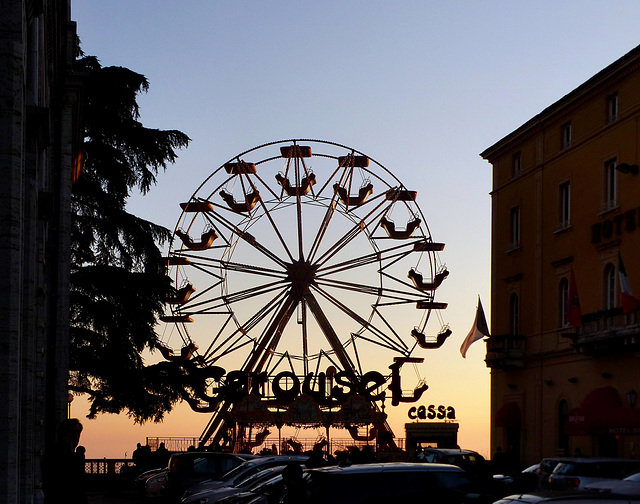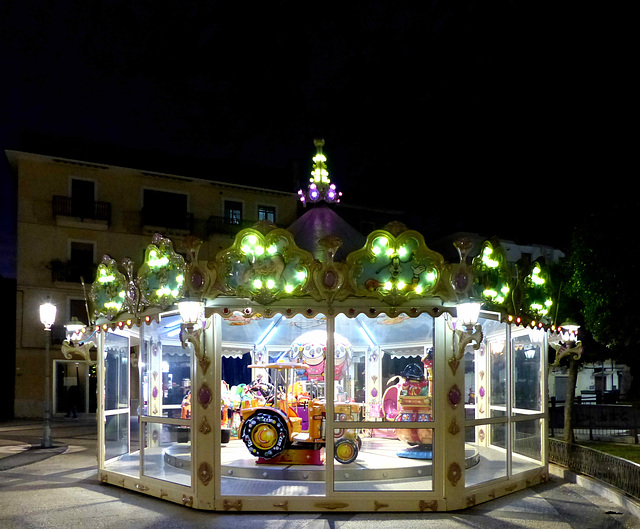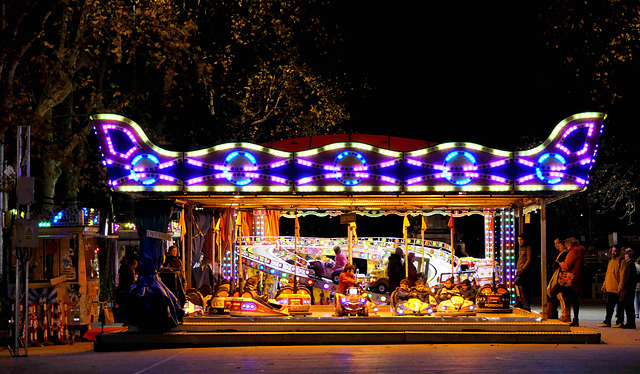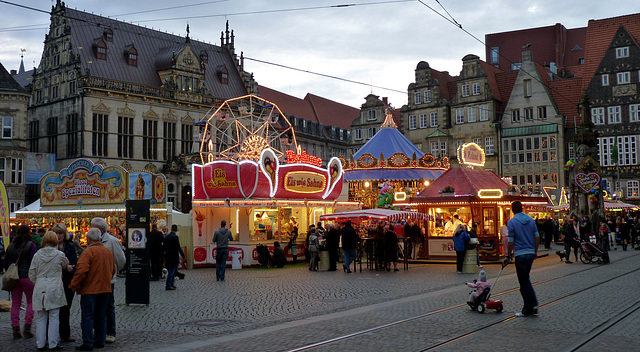
Ferris wheels and carousels
Perugia - Sunset
The sun sets pretty early in winter.
Poulseur - Monaco F1
Even though the "Circuit de Spa-Francorchamps", the venue of the "Formula One Belgian Grand Prix", is only about 40 kms east, the "Monaco F1" track seems to be more attractive in Poulseur.
Poulseur - Monaco F1
Even though the "Circuit de Spa-Francorchamps", the venue of the "Formula One Belgian Grand Prix", is only about 40 kms east, the "Monaco F1" track seems to be more attractive in Poulseur. This may be connected to the wide variety of means of transportations. Here are jet-planes, bikes and even buses.
Fondi
The first historical reference to Fondi dates to 338 BC, at the time of the Latin War, when its inhabitants gained minor Roman citizenship status. The importance of Fondi lay in its position across the old Via Appia, the main roadway from Rome to southern Italy.
In the 6th century, Fondi was devastated by the Lombards but remained a dominion of the Eastern Roman Empire. Later a part of the Papal States, in 846 it was burnt out by the Saracens they settled there until they were defeated in the naval battle of Circeo of 877.
In 1140 Fondi passed to the Dell'Aquila family, of Norman heritage, and then, in 1299, to the powerful Caetani barons, who for two centuries made Fondi the center of their power.
Late in the evening...
Segovia - Ferris wheel
A Celtic castle existed here, from which resistance against the Romans originated. The city was nevertheless taken. Afterward, it began to be built as a Roman city and became an important Roman military base.
In the second half of the 5th century, Segovia became part of the Visigoth Empire. From the 8th to the 11th centuries, Segovia was under Moorish possession. In 1085 Alfonso VI conquered the city. From the 13th to the 15th century it was a royal residence.
In the evening, when it is dark and all the lights are flickering, the Ferris wheel will be irresistible for children.
Valladolid - Christmas Market
In the 8th century, Arab-Moorish armies advanced into the north of the Iberian Peninsula, but as early as the 10th century the area was temporarily reconquered by the Christians (Reconquista). In the late 11th century, Count Pedro Ansúrez made the largely depopulated city his residence, expanded it, and promoted its repopulation (repoblación), which is why he is often considered the actual founder of the city. The University of Valladolid was founded in 1241 by Alfonso VIII of Castille. It is one of the oldest universities in the world.
In the 15th century, it became the capital of the Kingdom of Castile until Philip II moved the center of power to the newly built monastery residence Real Sitio de San Lorenzo de El Escorial near Madrid in 1561. In 1561 most of the city burned down but was rebuilt under Philip II.
Nuestra Señora de las Angustias is a representation of the Virgin carved by Juan de Juni after 1561. It is venerated by the" Ilustre Cofradía Penitencial de Nuestra Señora de las Angustias" (Penitential Brotherhood of Nuestra Señora de las Angustias). The brotherhood was founded in 1536 and had this church built end of the 16th century.
Night Riders
Bremen - Bremer Freimarkt
"Bremer Freimarkt" is one of the oldest fairs in Germany, first held in 1035 after Emperor Conrad II (aka "Conrad the Older") had granted the right to hold a fair to Archbishop Bezelin. In the 14th century the right was transferred to the civil authorities and since 1339 the word "Freimarkt" was used. Not only goods were traded, but as well "entertainment" entered the Freimarkt. Already in 1445 a lion got displayed here, followed by bears, monkeys and camels.
Today about four million visitors come to Bremen each year during Freimarkt.
Seen here is the market place. The "Bremer Roland", a statue of Roland, erected in 1404, is seen to the right. Roland was paladin of Charlemagne and hero of the Battle of Roncevaux. Roland is shown as protector of the city. He holds his legendary sword Durendal (that today can be seen in Rocamadour, France). The 5.47 m tall statue is "embellished" by balloons and a large heart with an "ISCHA FREIMARKT" inscription.
Merida - Plaza de España
In the Roman Empire, the city was known as "Emerita Augusta", the capital of the province of Lusitania. It was founded in 25 BC by Emperor Augustus as a colony for the veteran soldiers ("emeritus") of the Roman legions. The city was very important in Roman Hispania. It was endowed with all the comforts of a large Roman city and served as the capital of the Roman province of Lusitania. For centuries, until the fall of the Roman Empire, Mérida was an important economic, military, and cultural center.
Following invasions from the Visigoths, Mérida remained an important city of the Visigothic Kingdom of Hispania in the 6th century. In 713, the Arabs conquered the city and devastated it. Even under Islamic rule, Mérida remained a bishop's seat until it was moved to Santiago de Compostela in 1119.
In 1230 the Christian troops under Alfonso IX conquered Mérida during the Reconquista.
This square has been a marketplace since its founding during the time of the Catholic Monarchs. It was also used as an arena for corridas, a place for executions and processions. Government buildings have been built on this large rectangular square since the beginning of modern times until today.
There is a relaxed atmosphere here today. While the children ride the carousel, parents or grandparents drink coffee or wine.
Brighton - Flying Planes
In the 1960s, when "Swinging London" was the hub of the world, I spent three summer holidays in the UK as a teenager. I was a hitchhiker and never knew where I would end up in the evening and many nights I spent outside in a sleeping bag.
I was fascinated by this glittering, sparkling Brighton in the 60s. We have both grown older.
Jump to top
RSS feed- Latest items - Subscribe to the latest items added to this album
- ipernity © 2007-2025
- Help & Contact
|
Club news
|
About ipernity
|
History |
ipernity Club & Prices |
Guide of good conduct
Donate | Group guidelines | Privacy policy | Terms of use | Statutes | In memoria -
Facebook
Twitter










